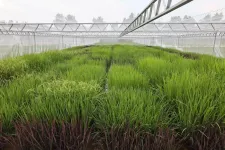Epigenetic targets and genomic stem cell pathways drive adult hair regeneration
Retrotransposons are interspersed repeating sequences that make up over 40% of the human genome. Proper tissue regeneration requires they be tightly regulated, but little is known about how this process is coordinated. To provide insights, researchers led by Yejing Ge, Ph.D., studied laboratory models of hair follicle stem cells in the skin. When injured, these stem cells change to help restore the skin barrier but eventually become exhausted. The researchers found an epigenetic regulator, SETDB1, driving retrotransposon suppression to protect regeneration. Removing SETDB1 led to the induction of a viral type of retrotransposon along with viral-like particles, resulting in hair loss and stem cell exhaustion. Antiviral drugs reversed this condition and led to hair cell regeneration. The researchers identified at least two involved pathways – antiviral-dependent and independent host responses toward reactivated retrotransposons – which potentially can be leveraged to deter tumor development and innovate cancer treatments. Learn more in Cell.
MicroRNAs serve as potential blood biomarkers for COVID-19 severity in cancer patients
Immunocompromised cancer patients who are infected by SARS-CoV-2 are at risk of developing severe COVID-19 with potentially fatal complications. Biomarkers capable of predicting those most at risk could help physicians better treat these patients. Researchers led by Simone Anfossi, Ph.D., and George Calin, M.D., Ph.D., identified several microRNAs – small non-coding RNA molecules – located close to genomic regions associated with the severity and susceptibility of COVID-19. The researchers analyzed plasma samples from 128 cancer patients infected by SARS-CoV-2. Levels of specific circulating microRNAs were associated with an increased risk of COVID-19-related death, making them an attractive prognostic biomarker. Further investigation is needed to understand this association, but similar methods could also identify at-risk patients for other common viral infections, like influenza, seasonal coronaviruses and cold viruses, which can negatively impact cancer patient prognoses. Learn more in Molecular Cancer.
Novel protein complex drives lung regeneration and suppresses lung fibrosis
Many chronic lung diseases lead to fibrosis, a condition in which lung tissue becomes irreversibly scarred and stiff, partly due to a failure in activating cell regeneration. Researchers led by Bongjun Kim, Ph.D., and Jae-Il Park, Ph.D., used a comprehensive approach to examine the mechanisms involved in lung cell repair. They identified a protein complex, PCLAF-DREAM, that plays a crucial role in helping lung cells regenerate after injury. The complex transforms specific precursor cells in lung alveola into a different type of cell that facilitates lung repair and oxygen exchange. In lab models, reducing PCLAF led to impaired lung regeneration and the development of fibrosis. The study also identified a viable drug candidate, phenelzine, that closely mimics the effects of this complex, suppressing lung fibrosis and promoting regeneration. Understanding the processes and pathways involved in alveolar cell regeneration can inform novel treatment strategies to help prevent lung fibrosis in patients with various lung diseases. Learn more in Nature Communications.
Vaccine-based combination therapy improves antitumor immune responses in melanoma
Tumor-specific neoantigens (neoAgs) are unique to cancer cells, making them viable targets for therapeutic cancer vaccines. However, little is known about the mechanisms underlying these neoAg vaccines and how they compare to immune checkpoint therapy (ICT). Researchers led by Sunita Keshari, Ph.D., and Matthew Gubin, Ph.D., characterized changes within immune populations following treatment with neoAg vaccines and ICT in models of melanoma, leading them to identify cell subsets and potential biomarkers that provide insights for improving treatment strategies. The study highlighted differences in the way neoAg vaccines and ICT affect immune cells, discovering that combining neoAg vaccines with ICT elicited a greater immune response in these models. Additionally, they noted that a specific type of suppressive macrophage expressing TREM2 expanded after vaccine treatment, but these cells were suppressed by ICT. Adding TREM2 blockade to the neoAg vaccine blunted this suppressive macrophage population, further enhancing neoAg vaccine efficacy. Learn more in Cell Reports.
Study evaluates alternatives to hypomethylating agents
Hypomethylating agents, like azacitidine and decitabine, block epigenetic DNA methylation. These drugs are standard treatments for hematological disorders but come with dose-limiting toxic side effects, highlighting a need for other treatment options. Quinoline-based compounds also can induce DNA demethylation, offering a promising alternative. To provide further insights, Xiaodong Cheng, Ph.D., led a group of scientists in characterizing the epigenetic effects of 15 quinoline-based compounds on human and bacterial DNA methyltransferases. Six of the compounds inhibited DNA methyltransferases, while two also significantly changed the shape of the DNA to inhibit various enzymes, leading to apoptosis, or programmed cell death. Additionally, one compound also elicited a DNA damage response in cancer cells via activation of the wild-type p53 tumor suppressor. The study highlights the potential of quinoline-based compounds to target cancers harboring wild-type p53. Learn more in Cell Chemical Biology.
Awards and honors
Khaled Elsayes, M.D., professor of Abdominal Imaging, and Carin Hagberg, M.D., professor of Anesthesiology and Perioperative Medicine, were awarded the 2024 Regents Outstanding Teaching Awards by The University of Texas System Board of Regents Phyu Aung, M.D., Ph.D., professor of Pathology, was awarded the Lifetime Achievement Award by the College of American Pathologists (CAP) In case you missed it
Read below to catch up on recent MD Anderson press releases.
Combining targeted therapy and immunotherapy improves overall survival in patients with anaplastic thyroid cancer MD Anderson expands arts experience program to enhance healing and well-being for patients Funda Meric-Bernstam, M.D., elected to National Academy of Medicine Read this press release in the MD Anderson Newsroom.
- 30 -
END






